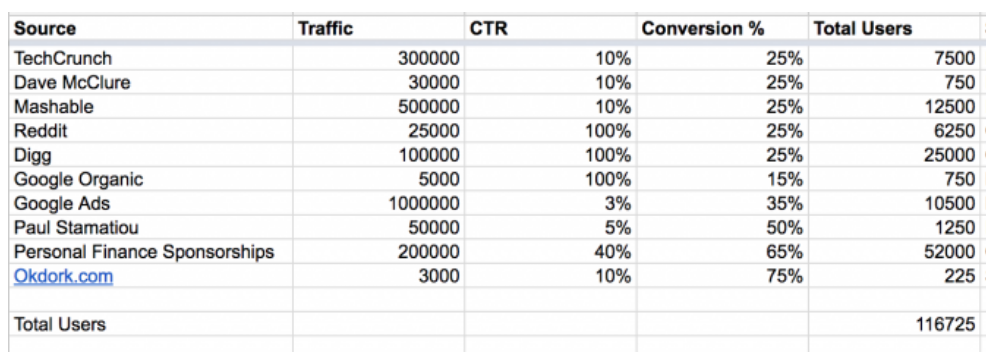Menu

Let’s face it: marketing is NOT easy. But it IS possible to do the right things in order to accomplish your business goals.
So, how do you test marketing channels and create a solid marketing plan? Having worked at high-growth startups, as well as with my clients, I’d say that this is a heavy—but VERY important—topic that senior marketing leaders and leadership in general ought to invest in. I imagine there are plenty of marketers out there who are uneasy about their approach. They may not even have a process at all (Yikes!).
Having a systematic approach and framework to follow helps ensure that you’re covering all your bases in order to maximize results.
How does one figure out which systematic approach to use? After all, there are a bajillion articles, blog posts, and books on the topic. The approach I’m recommending is not shiny and new; it stands the test of time.
In Part 1 here, you’ll learn 7 of the 10 steps (Bullseye Framework).
In Part 2 (next post), you’ll learn the last 3 steps (Marketing Plan creation).
Let’s jump in!
Well #1: It’s planning … if you have a plan, you can feel confident you’re working toward your end goal(s). Love that feeling.
#2: You’re more likely to spend time on the stuff that makes the biggest impact (see 80/20 rule).
#3: It’s a tool that helps you implement direct response marketing, where you get measurable ROI (as opposed to branding and mass marketing, typically done by large companies with million dollar marketing budgets).
Now, onto the fun stuff! The framework I’m going to refer to is called the Bullseye Framework, which I read about in Traction. I love this book. It is well-written, extremely helpful, and still applies years later. The quotes featured here are directly from the book.
The Bullseye Framework is a “systematic approach to uncover strategies for getting traction with customers that you wouldn’t have found using other approaches,” … a way to zoom in on the best ideas quickly and cheaply, and allows you to run tests in parallel (so you don’t lose valuable time).
Aha! Note: If you’re creating a marketing strategy from scratch, I’d recommend you first gather foundational information to understand the business and prospective clients, including buyer persona(s). More on voice of the customer research and creating buyer personas (love them!) in a separate post.
To begin, start with a competitive analysis to:
Create a spreadsheet and think of at least one idea for every marketing channel.
Aha! Note: The only channel that’s missing from the 19: postal (direct) mail! I’m not sure why it wasn’t included in the book. Email does not replace postal mail. Send a Shock ‘N Awe Package for goodness sake!
Some other items you may want to include:
Here’s an example of a simple spreadsheet with columns and ranking:

Here’s an example spreadsheet that Baremetrics put together. Here's one that I put together that you can use, just create a copy and tweak.
If you’re using either one of the example spreadsheets with a scoring system, then you’re all set with picking the top 3 and you can skip to #5. If you’re not, that’s fine too! Just place all your channel ideas into one of three columns: Inner Circle, Promising, or Long Shot. You should feel pretty strongly (AKA: excited!) about 2-3 channel ideas (your Inner Circle).
Pick your top 3 traction channel ideas. Simple.
“Keep in mind that, when testing, you are not trying to get a lot of traction with a channel just yet. Instead, you are simply trying to determine if it’s a channel that could work for your startup.”
In general, you should be spending about $200-$300 to get a rough idea of a channel’s effectiveness. That is to say, you don't need to spend a lot to understand marketing channel effectiveness.
For example, let’s say you want to test a social influencer strategy. You contact the top six social influencers and ask if they’re interested in trying your product (spending $100 on each), and then create a social and/or blog post about it. Three agree and one of their fans ends up purchasing your product. Your spend = $300. Your sales = $100. Now you know you should probably look into other channel strategies and you didn’t need to test with 20 social influencers (spending $100 on each).
The tests should be designed to answer specific questions including:
Here’s an example from Noah Kagan and Mint.com (a site that helps you track your finances; Intuit bought Mint for $170MM). You can see those traction channels that were most successful for them. More from Noah’s approach here.

By simplifying and focusing, you spend time on what matters (80/20!). Focus on the traction channel where the testing actually worked. Direct your traction time and resources into that channel. This is especially important for high-growth startups that have limited resources.
“At any stage in a startup’s lifecycle, one traction channel dominates in terms of customer acquisition.”
Aha! Note: As your company grows and you have more time/resources, you’ll have other goals besides acquiring customers, such as increasing email subscribers or increasing website visitors. You’ll want to optimize your strategy depending on the most successful channels for your company (more on multi-channel marketing in a separate post).
Allan Dib (1-Page Marketing Plan) recommends having “at least five different sources of new leads and customers” so you don’t put all your eggs in one basket and leave your business vulnerable to changes outside your control.
If no channel seems to work, you can repeat the process again.
“The good news is you now have data from all the tests you just did, which will inform you as to what types of things are, and are not, resonating with customers. Look at the messaging … dig deeper to see at what point each channel failed to deliver customers.”
Now that you’ve tested some channels and (hopefully!) gotten a sense of which one(s) work, you’re ready to create your 1-page marketing plan. Check out the next post: 3 Steps to Create a Winning Marketing Plan.
Are you a VC funded startup that needs help with your marketing? Book a free 30 minute consultation. I’ll ask you some questions about your product, the problem it solves, your buyer, your marketing efforts, and business goals. We’ll get to know each other. I’ll try to help you right away.
Top 5% podcast exploring the role that customers play in helping companies build to their next level of growth. 250+ episodes, 4.8 stars.
One Insight is a newsletter that highlights one unique insight I’ve uncovered, been thinking about, or seen in the wild. It usually makes me go "woah."